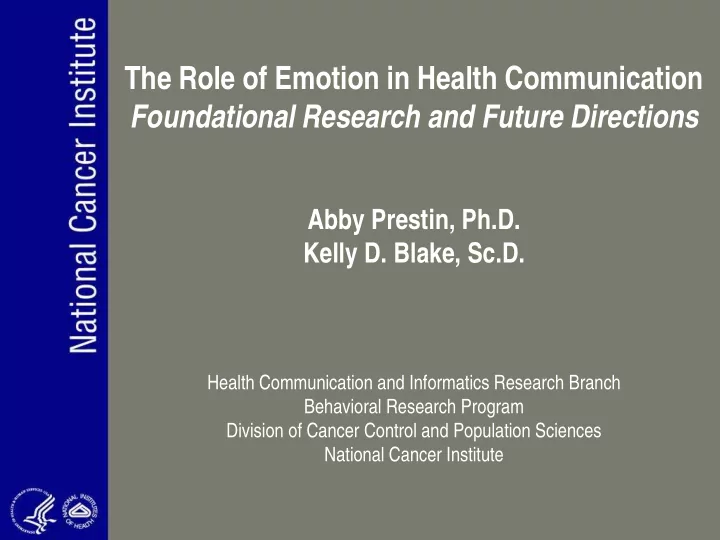

The Role of Emotion in Health Communication Foundational Research and Future Directions Abby Prestin, Ph.D. Kelly D. Blake, Sc.D. Health Communication and Informatics Research Branch Behavioral Research Program Division of Cancer Control and Population Sciences National Cancer Institute
Overview: Emotion & Health Communication Research in Cancer Control Media Effects Research – Emotion as a mechanism for media effects • Framing, persuasion Selective Exposure – Emotion as a motivation for selective exposure to media • Uses and gratifications, mood management theory, social comparison • Information seeking, recovery gratifications, coping (Weaver, 2007; Iyengar, 1982; Reese, 2001)
Emotion as a Mechanism for Media Effects: Foundational Research Framing – News media coverage of health topics heightens salience of health-related issues and influences the public’s knowledge, attitudes, and behaviors. – Use of frames and angles in reporting – Commonly used frames/angles • Public impact, economic impact, controversy, human interest, personal behavior change (Weaver, 2007; Iyengar, 1982; Reese, 2001)
Emotion as a Mechanism for Media Effects: Current and Future Research Framing – Framing health disparities in cancer mortality data • disparity or progress frame emotional reaction individual- level screening intentions versus policy implications – Related concept: gain-frames and loss-frames
Emotion as a Mechanism for Media Effects: Foundational Research Persuasion – Discrete emotional appeals • Fear appeals: Messages include threat component, which motivates protection/escape behavior; message also provides response information • Theory to predict/explain effectiveness of fear appeals, guide message design – Limited work on other negative emotional appeals • Guilt, disgust, anger, regret
Emotion as a Mechanism for Media Effects: Current and Future Research Persuasion – Investigate content or design features that evoke a broader range of emotions • Design elements • Effects on health-related KAB – Positive emotional appeals – Greater recognition of emotional barriers to health behaviors
Emotion as a Mechanism for Media Effects: Current and Future Research Persuasion – Understand why emotional appeals boomerang or have unintended effects (Dillard & Nabi, 2006) • Arousal of multiple/blended emotional responses • Mismatch between message content and core-relational theme of target emotion • Message intensity • Individual differences influence message reception and response (e.g., coping styles, sensation seeking)
Emotion as a Mechanism for Media Effects: Current and Future Research Persuasion – Is social media changing the game? • Enthusiasm over the ability of social media to widely disseminate health messages cheaply and easily • But, audience can enhance or impede effectiveness • Social sharing of emotional media content – Greater intensity of emotion enhances likelihood of sharing (Rime, 2009) – Role of emotion in “viral” videos?
Emotion as a Motivation for Selective Exposure: Foundational Research – Uses and gratifications paradigm (Katz et al., 1974) • Social support, escapism – Mood management theory (Zillmann, 2000) • Stress relief – Social comparison to media characters (Mares & Cantor, 1992) • Self-improvement, self-enhancement, emotional experiences
Emotion as a Motivation for Selective Exposure: Current and Future Research – Mood management theory • Alternative affective needs (e.g., eudaimonia Oliver, 2008) • Discrete emotions (e.g., Nabi et al., 2006) • Measure post-viewing emotion – Role of emotion in social comparison to media characters? – Role of emotion in social cognitive processes? – Emotion and online information seeking • Anxiety and info seeking, retention (Turner et al., 2006) • Dissatisfaction (Knobloch-Westerwick et al., 2009)
Emotion as a Motivation for Selective Exposure: Current and Future Research – Recovery (Reinecke, 2009; Reinecke et al., 2011) – Coping • Connecting via social media – Sharing personal illness narratives (Chou et al., 2009) – Social support, emotion regulation (Chung & Kim, 2008) – Patient social networking (e.g., PatientsLikeMe) – Sharing/broadcasting emotion states (3GT, Aurora) • Media-generated positive emotions to sustain coping • Problem-focused coping and modeling
Conclusions • Need for systematic inclusion of emotion-related constructs in health communication research • Need a better understanding of the conditions under which emotion-based messages influence health-related knowledge, attitudes, and behaviors – Moderators of effect of emotion-based strategies • Need to think about how people use media to manage emotions, cope with stress and implications for health • Greater inclusion of emotion or affective constructs into health behavior change and media effects theories
Recommend
More recommend